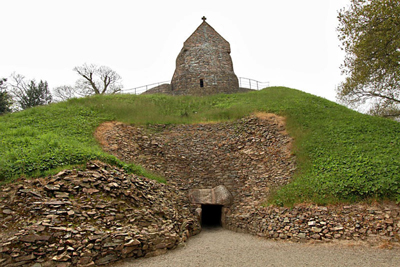
La Hougue Bie, the 6000-year old historic site in the parish of Grouville in the Jersey Island, the largest and southernmost of the Channel Islands, located off the French coast of Normandy, is considered as one of the best conserved remnants of the Neolithic period in Western Europe. It is evident that the name comprises two words. The first part of the name, Hougue came from the early Norse word ‘Hougr’ and when French became the language of the Islands, it was softened to Hougue, which stands for mound. Bie, the second part of the name stands for homestead. Thus, the name could mean the homestead near the mound.
The archaeological site of La Hougue Bie includes one of the most well-preserved and protected passage graves in the world, which were constructed out of giant stones forming a crawl space through a mound of earth. The 61 feet (18`6 m) long passage chamber was covered by a 40 feet (12`2 m) high earth mound. It was a ritual site of the Neolithic period, which was in use around 3500 BC. Although they are termed as passage graves, they were ceremonial sites, whose function was similar to churches, where burials were incidental. There are two medieval chapels on the top of the mound, one from the 12th Century and the other from the 16th Century.

Richard Mabon owned the property in 1509, when he became the Dean of Jersey and as a thank offering for his safe return from a pilgrimage to Jerusalem, he restored the old chapel, rededicating it to Our Lady of Loretto, the Assumption and St Michael.
He also added a second small chapel against the east wall, which came to be known as Jerusalem, in which Masses could be held for the souls of his own family. There are some faded images of fresco paintings on the walls of the chapel, which were believed to be painted in the 14th century and can still be dimly discerned.

Much later, the property was bought by La Societe Jersiaise in 1924 and they started to excavate the site in 1924.In the process of excavation it was discovered that the long passage grave is oriented to receive the sun’s rays and illuminate the farthest recesses of the chamber on the solstice. The narrow passage leads to a larger chamber, with side chapels on the north and south. There was a smaller room on the west and further beyond that a square cell, like the Lady Chapel in a cathedral.

All of these were buried under a mound of tightly packed earth, so that the capstones could be placed as a roof on the whole. When it was opened, scattered bones of eight persons were found, of whom at least two were women. However, the items they buried with the dead are strong evidence of belief in the afterlife. As the bones of cattle were also found, along with the human bones, it was considered that probably those animals were left as food for the afterlife of the deceased. The presence of flint tools indicates that those ancient people believed that the departed persons would need them in their afterlife in the next world.
Except the mortal remains and the flint tools, nothing more than some fragments of pottery and two beads were recovered from the site. It evidences that some time in the remote past, the site had been invaded and ransacked. It was presumed that it was the Vikings, who were aware that prehistoric tombs often contained treasure.

The archaeological site of La Hougue Bie, managed by Jersey Heritage, contains the tenth oldest building in the world and one of Europe’s finest passage graves. During World War II, it was used as a key lookout point and was fortified with barbed wire, trenches and machine-guns. In addition to that, a 26 feet high temporary timber observation tower was also built on the top of the mound. After the Great War, it was turned into an Occupation Museum, exhibiting samples of things left behind by the enemy. The ancient treasures of the Island, which include the coin hoards, axes, swords and spears, are displayed in La Hougue Bie Museum, located in the north east of the island.